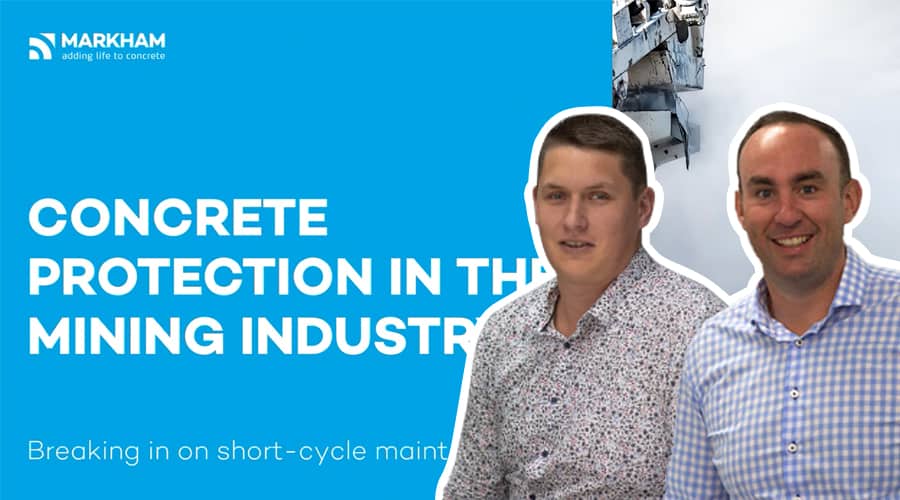Concrete Protection in the Mining Industry

Concrete Protection in the Mining Industry
Webinar Show Notes
Protecting concrete against hypersaline water: https://markhamglobal.com/news/hypersaline-water/
Bust the Short-Term Maintenance Cycle: https://markhamglobal.com/news/bust-the-short-maintenance-cycle/
Learning Outcomes
- Concrete under threat
- The secret to concrete service life
- Pushing out the maintenance cycle
BRENDAN: Hello and welcome aboard everybody to the latest MARKHAM webinar, “Concrete protection in the Mining Industry”. We’re going to be going over a number of important features for the industry, particularly looking at breaking in on short-cycle maintenance.
On our panel today we have with us Doug Hamlin and Hayden Prestidge. Doug and Hayden, would you like to introduce yourselves?
HAYDEN: Thanks, Brendan! It is a good day and a good topic to discuss! I’m Hayden Prestidge based in the Napier office at the moment. I’ve been with MARKHAM for eight years and come out of the construction industry. So yes, interesting topic, protection for the mining industry. So looking forward to this one. Doug?
DOUG: Yes, thanks, Hayden. So yes, Doug Hamlin, I’m actually based in the Perth office in Western Australia. I’ve been with MARKHAM for just on 13 years, working right from project management, applications right up to technical validation, and working in the mining and civil space today. So, over to you.
BRENDAN: Very good. Thank you very much. All right, we’ll just pass to the learning outcomes and Hayden, you can take us away.
HAYDEN: Thanks, Brendan, and thanks to everybody that’s joined. Thanks for taking some time to keep learning, and keep developing, and to ensure we do the best for concrete, moving forward. So let’s have a quick look at what we’re going to be talking about, and some of the outcomes we want to achieve at this session.
So we really want to talk about the concrete under threat; the threats that come onto concrete through this mining sector. Obviously remote areas, harsh environments; and so really understand that.
We want to look at the secret of how to extend that service life in in this concrete. Now some of you may know MARKHAM, but we’re all about extending the life of concrete. That’s the service life. That’s the durability of concrete. So we look at the secret of that.
And then we really want to look at pushing out the maintenance cycle, so getting more out of your concrete; maximising the return, so to speak, and getting the most out of the concrete.
So if we jump into this… but first I think it would be good to really understand some of the roles that are out there that are on this call, if you want to just put a note into the chat function at the top of the screen there. And good to understand, engineer, architect, asset owner, whatever you are through there. As we go through, also, please feel free to use the Q&A button. We will have a Q&A session at the end. So any questions you’ve got that come into your mind, put them into the Q&A function and we’ll make sure we get that.
So thank you very much. Good to see the type of people we’re working with, that’s good. Thank you. Helps us tailor the conversations.
Cool, right. Let’s have a look. Concrete under threat. What are the threats out there for…? But this is really particular to the mining industry now. So if you think about some of these locations, and some of the treatments, and some what’s happening on top of this concrete, is what we’re thinking about here. So what are some of the challenges that we’re facing in this space?
We’ve really got to think about chemical and acid attack, and including that hypersaline wastewater environments, that are really, really harsh on concrete, on the cover concrete. You know, corroding that surface and getting through to deterioration.
And then we’ve got to think about extreme fluctuations of weather. Where nature plays its part; in some cases freeze, the freeze of moisture in concrete, and then right through to that really hot weather. So even building structures in that weather, pouring concrete in that weather, right to protecting concrete in that weather. These are huge factors that can threaten the performance of concrete.
And steel corrosion. You know, you get your steel in there, but as contaminants and water and things are getting through to that steel level, and chloride etc that are breaking down and causing expansion and blowing concrete cover.
You’ve got to think about ASR and DEF. These reactions from minerals and concrete. So now some of the minerals used in some of the concrete locations and readymix can have some contaminants in them. Just based on the location to the sand, the aggregates; and especially mixed with that, with the temperature and environment, can really become a bit of a breeding ground for these reactions, so how to protect against that?
Right. Negative impacts; how that happens. We’ve looked at some of the threats, but what’s the impact of that? The impact of that is premature deterioration of your structure really. So it’s loss of cover, loss of quality, loss of surface; and that really leads into costs of downtime, cost of maintenance. Big impacts when you’re running a huge organisation, or building a new structure, or asset managing a structure. These are big, big impacts that really have effect that a lot of people don’t take into account; but that’s what we’re trying to work against is saving you that impact.
Think about that short-term maintenance cycle. You know, where you just get onto a repair treadmill, so to speak. And you have to be ongoing teams, ongoing costs, ongoing shutdowns to keep up with maintenance.
And then, probably the biggest impact obviously is the shortened project life or structure life. And that obviously means a rebuild, and the huge cost of planning and resources that need to go into something like that. So that’s the huge impact there.
But then also we’re going to think about some of the impacts of ways of getting concrete durability. You know, is it safe? Are some of the mixes that we’re using safe? Some of the chemicals … are the concrete structures safe themselves? Some of the mix designs, you know, are they easy to work with? Things like that.
These are some of the impacts that are out there in the industry. So Doug, we’ve talked about some of the problems, some of the impacts. What’s the secrets on the counter to all this?
DOUG: Yes. Thanks Hayden, it’s good to understand that, you set it out well. So I guess it’s important to understand why concrete deteriorates in the first place; and it really comes down to the fact that all concrete, whether it’s, you know, a 25-30 MPA or 60+ MPA. There is still an element of moisture that will be able to move through that concrete and…
Why that is a problem, is that that moisture is the vehicle, or it carries contaminants through the concrete structure, which, you know, start to attack the concrete, lower its pH; which obviously concrete has a high pH for its natural protection. And as we get these contaminants into the concrete, they start to break that down.
A very harsh example is where you’ve got a strong acid. Might be a sulfuric acid or something. And it’s a very low… You might be 1 or 2 pH, and concrete sitting at about 12 pH, and they obviously want to meet in the middle. And so the acid just eats away at the concrete.
But back to the moisture discussion. So obviously moisture moving through concrete can carry these contaminants, but there’s another part and that is, that moisture is… or for steel corrosion to take place, which is of the reinforcing steel, you need moisture. You need an acid. So whether that’s chloride like salt, or whether that’s carbonation, or acid attack, whatever it may be. And then thirdly, you need oxygen.
So if you can take that moisture out of the equation, if you can control the moisture, you not only stop the contaminants getting into the concrete and breaking it down, but you also take the moisture out of that corrosion equation. And those two factors work to extend the service life of the structure; so that cover concrete is getting the best service life that it possibly can, you know? And it’s not breaking down as fast as it normally would.
So how do we control that moisture? At MARKHAM, we work with hydrogels. These are one of the few treatments that we know of that actually get inside the concrete and stop that moisture movement where it needs to be stopped. So there’s a lot of treatments out there that work on the surface, and work at a barrier level on the surface. But actually penetrating into the concrete, working inside that cover concrete, is where we need to be.
So as far as what a hydrogel actually is, it’s based on a colloidal silica which is a very small particle size. It’s basically means it’s silica suspended in liquid. And what it does is, it reacts with the alkalis and the calcium hydroxide, mainly in the concrete pores, and it forms a calcium-silicate-hydrate gel; which is the same format as the cement paste itself inside the concrete. So effectively what we’re doing is … the porosity and concrete where that moisture moves through, we’re filling that up with gel that’s very similar to the cement paste itself. And what that does is it stops the moisture being able to get through, and it also makes the concrete more dense. So any attack – acid attack and things like that – on the surface of the concrete is, as you know, vastly slowed down.
And just lastly, as a company we are very project-specific. So we work end-to-end; we work from looking at a structure when it’s still in design; thinking about problems that the structure is going to be exposed to; right through to on-site supervision, and installation, and things like that. So it’s right the way through the project, MARKHAM is involved; and there’s a real commitment from our team to make sure that each product is installed correctly and it is the right product from the get-go. Anything else to say on that one Hayden?
HAYDEN: No, it’s good. I just… anyone that’s got questions, please pop them in there while they’re in your head and we’ll get to those in a minute.
But so really what – I think Doug set it out well – how we protect the concrete is by protecting the internal matrix. And really what we’re doing by doing, that is pushing out that maintenance cycle. So we’re given the concrete its best chance of survival, so to speak. We’re arresting that potential corrosion, potential deterioration early, and pushing it out by acting early.
Now this… on the right of your screen there; you can see these four different phases. Australia Concrete Repair Association actually put this out not too long ago; but they’re saying a dollar spent in the design phase, in that early phase, really saves you 125 times that value if you leave it and leave it and leave it; where you basically get to that point of, you have to rebuild because you didn’t take… you didn’t protect that concrete early enough. You let corrosion cycle start and then it took over. And then obviously took over the whole structure. So if you’re thinking about that. $1.00 spent in planning and looking at the right product, the right approach, early, saves you 125 times from that premature deterioration of that concrete structure down the track – hopefully, does that make sense how I’ve put that out Doug?
DOUG: Yes, it does, yes.
HAYDEN: It’s no one’s… often you know… there’s quantity surveyors on this call, there’s asset owners; but it’s often not thought about at that time, you know, what’s in the budget for maintenance? What’s in the budget down the track to look after the structure? If you can have that mindset of, what do I need to do now to save me down the track? – I think is a good approach. So that’s really what we’re talking about when we’re pushing out that maintenance cycle.
You’re probably thinking, where do we use all this type of thing? We’ve pulled 3 examples we’ll just quickly have a look at. Doug can lead you through these, just to show the type of environments we get involved with.
DOUG: Yes. Thanks Hayden. So the first one we’ve got here is the waste energy plant out in East Rockingham. So as you can imagine, an environment like this, all sorts of chemicals and waste being processed here. We did a lot of protecting of the concrete slabs, and this was right from day one. So as a cure to the concrete. So the very, very best time to get on and protect concrete, right from that first day of its life, so to speak. One of the areas that was particularly of interest was where they were storing the ash. And there was a high risk of acid attack on the surface of the concrete; so not only protecting the reinforcing steel, but also increasing that abrasion resistance, increasing that density at the surface of the concrete, helps mitigate the acid attack. Yes, anything else to say on that one, Hayden? That’s pretty much it, I think.
HAYDEN: No, that’s good. Just probably the fact that that was that was… just to reinforce that that was done from day one. So when they’re building this, coming on as a cure, giving that concrete its best opportunity right from the start.
DOUG: That’s awesome. So the next one, this was a project that was applied as an existing structure. So not only can you apply at day one, which is the best time; if you are noticing signs of your structure starting to deteriorate, you can apply it at that stage; or if you’ve just done repairs, things like that, these those are all good times to apply. Obviously it’s kind of a sliding scale as to the benefits you get. But yes, there is still real benefit there. So this particular project had a lot of repairs that were needed. It had some steel reinforcing corrosion, had caused spalling. The repairs had been done. And then we applied the AQURON 7000 product as part of the CIVIL-TECT system. And to make sure that those that repairs that had been done were protected, and the parent concrete around the repairs wasn’t compromised in the future. So I like to think of it as, if you repair a certain part of a wharf, the concrete beside it and around it isn’t actually too far away from getting to the stage where it’s spalling as well, so it’s a good idea to protect it. On this particular project we got quite involved with the engineer and the site contractor there; and what we did was, did a permeability test at every 250m2 along the wharf, so we’re able to show every single section of that wharf, that we were decreasing the permeability of that concrete; and stopping that moisture from getting in and feeding that corrosion equation.
So the Albermarle lithium plant, this was a good sized project in WA here. When this project was poured, it was extremely hot weather; it was around the 40°C mark, some just above, some just below. But obviously the project had to carry on. What we were doing there was getting on basically as soon as the trowels had done their last pass, and we could walk on the slab without it marking. We were getting in and spray-applying the hydrogel treatments. Now what this did, it not only protected the concrete slab but it also acts as a cure. So it stops that moisture loss from the concrete. And following on from that, it stops or heavily reduces the amount of cracking that you get in these slabs. So lots of the concrete contractors, the site managers, things like that, were very, very impressed, compared to what they’ve seen in the past, where it was cracking up fairly quickly, even on the same day sometimes, after the pour. Once the hydrogels are applied, because it stops that concrete from drying out too fast, essentially you get a lot less cracking, which flows on to having a much better service life as, if you’ve got cracks in your concrete, it speeds up that contaminant, that acid ingress, things like that. So yes, obviously that was day one. And then flowing on from that, there’s obviously chemicals being stored on slabs; and big loaders, things like that crashing around on the slab. So it’s a fairly harsh environment; and achieving a durable concrete was very important there. So I think that covers that one.
As far is questions, what have you got there, Brendan?
BRENDAN: Yes. Thanks very much, Hayden and Doug, that’s been really good. We’ve had some questions come in here. So the first one is, How much longer does the treatment make the concrete last?
DOUG: It’s a good point. It does vary depending on the environment. Obviously some environments are slower to deteriorate the concrete, others are a lot quicker. The one example I like to talk about that demonstrates it is the Murrin Murrin mine site. Now that’s a very, very old mine site. A lot of chemicals being used to process the nickel and the other minerals there. And what was happening is they were pouring concrete. It was very, very hot, very dry. Some of the concrete was cracking up fairly quickly after the pour; and then they were, you know, putting acid resistant coatings on it, things like that. But they were getting around about 18 months, sometimes two years out of these slabs before they had to replace them. When we got involved, we put an admixture in the concrete, which made it easier to place. So you got a better quality job for a start. It reduced the moisture loss out of the concrete. So it reduce that cracking. And then we also spray-applied it as a cure as well. So we gave it the absolute best hydration of that concrete. And they’ve been able to get 4 to 4½ years, I think, some of those slabs are at now, and counting. What the secret is, though, is that even if the concrete does get hit by acid, if it’s protected with the hydrogel, it limits the attack to that top surface, so you push the service life out, whereas if it’s unprotected, it drips you know onto the concrete and slowly eats it away and it just keeps going further and further down into the concrete. There’s nothing to resist it. Does that makes sense?
BRENDAN: Yes, that’s very good. Thank you very much. I’ve got a question here: Do engineers usually specify this treatment or contractor/subcontractor propose the implementation?
DOUG: Take that one Hayden?
HAYDEN: Oh, the short answer is, both! It depends what’s involved there. If it’s the engineer… I mean, we work with all parties. An engineer that’s designing a new structure may often put something in for durability, and that goes back to that Law of Fives. Getting in early in the scenario; they’re thinking ahead, of what the structure is built for. But then a repair contractor absolutely as well; they get involved with condition surveys. They have to put forward a performance solution. And often that means repairs and a treatment to get the most out of a structure. Does that make sense?
BRENDAN: I think that’s helpful. And third question here, How often does it have to be re-applied?
HAYDEN: I’ll take that one while my mic’s open. Now the best thing… The beauty of it is, it’s a one-time treatment. It’s lifetime; you can’t reverse it; because of what Doug was speaking about earlier, you know, creating more of that calcium-silicate-hydrate in the concrete, you can’t reverse that once it’s happened. Once it’s transformed into that state, it’s always in the concrete. It basically just makes a denser, more quality concrete. So you can’t wear it. You can’t kill that hydrogel, so to speak; so it’s not a reapplication process.
BRENDAN: Fair enough. And perhaps just if you’d like to give us a wrapping up on that, Hayden, if that’s all right?
HAYDEN: That’s good. Thanks for the input of everybody. Thanks for taking time out of your day again.
We looked at … I’ll just reflect on some of the things we talked about, the threats to concrete. We looked at, you know, what are those environments? What are those chemicals? What’s the situations where they’re really hurting the concrete?
We talked about the secret being the hydrogel, which I’ll touch on a little bit more; and then obviously some case studies.
Why use concrete hydrogels for this type of environment? Very easy to work with, minimal downtime, can go on to new and existing concrete.
They really help to de-risk hot weather challenges, so ultimately curing as that first step of durability. So right from that stage.
Safe for the environment and everybody involved, right from batching concrete through to the placing and finishing of the concrete; there’s nil VOC; nil toxins; they’re envirolabelled products, so easy to work with.
But the key part really is the ability to extend service life of structures, and that’s what we’re passionate about, reducing maintenance cycles, pushing out maintenance cycles, reducing downtime costs, interruptions; and getting the most out of your concrete structure.
So hopefully that was beneficial. Thanks everybody for jumping on and we’ll be in touch, no doubt, moving forward. Thanks, Doug. Thanks Brendan.
DOUG: Thanks again, good times.
BRENDAN: Thanks very much, everybody. And we’ll send out a follow up email with the contact details of the presenters. Be free to get in touch with any project questions you might have.
More about MARKHAM
MARKHAM are dedicated to providing innovations for concrete and construction. Focusing on concrete waterproofing solutions, penetrating concrete sealers and durability treatments concrete.
Newsletter
Sign up for email updates on the latest collections, campaigns and videos.




